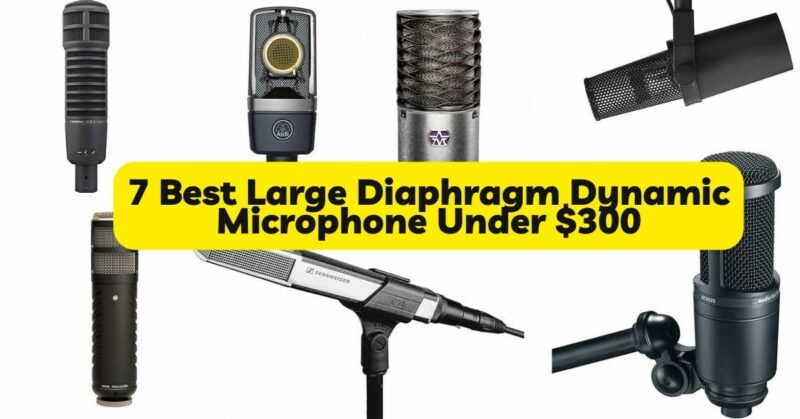When it comes to recording vocals, instruments, or podcasts, having a high-quality microphone can make a significant difference in the overall sound quality of your recordings. Large diaphragm dynamic microphones are particularly well-suited for capturing rich, warm, and detailed sound. While some of the top-tier options can be quite expensive, there are also excellent choices available at more affordable price points. In this article, we will explore the seven best large diaphragm dynamic microphones under $300. These microphones offer exceptional sound reproduction, solid build quality, and versatile features, all while remaining within a budget-friendly range. Whether you are a professional musician, a podcaster, or a content creator, these microphones will help you achieve professional-grade recordings without breaking the bank. So, let’s dive in and explore the top contenders.
Here are 7 highly recommended large diaphragm dynamic microphones under $300:
1. Shure SM7B

Pros :
- Exceptional sound quality
- Versatility
- Excellent off-axis rejection
- Rugged build quality
- Built-in pop filter
- Mounting options
Cons :
- Requires good preamp and gain
- Heavy and bulky
The Shure SM7B is a legendary microphone that has earned its place as one of the most revered options in the recording industry. It is highly regarded for its exceptional sound quality, versatility, and rugged build. Let’s delve into a detailed review of the Shure SM7B.One of the standout features of the SM7B is its ability to capture vocals with remarkable clarity and warmth. Whether you’re a vocalist, podcaster, or broadcaster, the SM7B excels in reproducing vocals with a rich, full-bodied sound. It has a flat, wide-range frequency response that ensures accurate reproduction, while its excellent off-axis rejection minimizes background noise and unwanted sound sources.
The microphone’s versatility is another aspect that makes it a top choice. Its selectable frequency response settings allow you to tailor the microphone’s response to suit different recording environments and applications. You can choose between three different settings to achieve the desired tonal balance and optimize the microphone’s performance for your specific needs.Built to withstand the demands of professional use, the SM7B boasts a sturdy construction that ensures durability and longevity. Its heavy-duty metal construction gives it a solid feel, and it can handle rigorous use without any degradation in performance. Additionally, the integrated pop filter helps minimize plosive sounds and reduces the need for additional accessories.One consideration with the SM7B is its relatively low output level, which means you’ll need a good preamp with sufficient gain to achieve optimal recording levels. While this can be seen as a minor drawback, it’s worth noting that the microphone’s low sensitivity contributes to its excellent off-axis rejection and helps minimize room noise.
2. Electro-Voice RE20
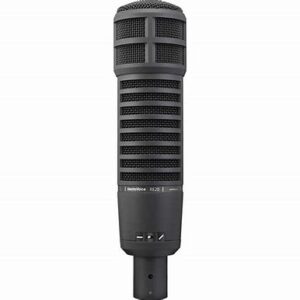
Pros :
- Exceptional sound quality
- Excellent off-axis rejection
- Robust build quality
- Versatility
- Internal pop filter
- Comfortable to use
Cons
- Price
- Requires a high-quality preamp
- Size and weight
The Electro-Voice RE20 is a classic dynamic microphone that has established itself as a go-to choice for professional audio recording and broadcasting. It is renowned for its exceptional sound quality and unique design. Let’s explore a detailed review of the Electro-Voice RE20.One of the standout features of the RE20 is its transparent and accurate sound reproduction. It captures audio with remarkable detail and clarity, making it a preferred choice for capturing vocals, instruments, and even sound effects. The microphone has a smooth frequency response that ensures natural and balanced sound reproduction, allowing the true character of the source to shine through.
The RE20 excels in off-axis rejection, thanks to its Variable-D design. It effectively minimizes unwanted background noise and maintains a focused sound, even when the sound source is not directly in front of the microphone. This makes it a valuable tool for recording in acoustically challenging environments or in situations where noise control is crucial.Durability is a strong suit of the RE20. It features a robust build quality that can withstand the demands of professional use. Its solid construction ensures long-term reliability, even when exposed to rough handling or high sound pressure levels. The microphone is built to last, making it a sound investment for studio owners and recording professionals.While the RE20 delivers exceptional performance, it does come with a higher price tag compared to some other dynamic microphones. This might be a consideration for those on a tighter budget. Additionally, the RE20 is a relatively large and heavy microphone, which may require a sturdy microphone stand or shock mount to ensure proper support during recording sessions.
3. Audio-Technica AT2020
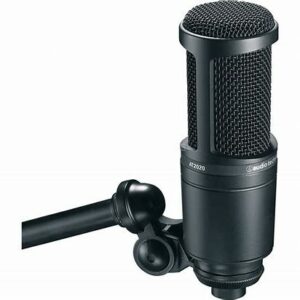
Pros :
- Sound quality
- Affordable price
- Versatility
- Solid build quality
- Low self-noise
Cons :
- Requires phantom power
- Lacks additional features
- Sensitive to handling noise
The Audio-Technica AT2020 is a widely recognized microphone that has become a staple in many home studios and recording setups. It offers a combination of affordability and performance, making it a popular choice for both beginners and experienced audio enthusiasts. Let’s dive into a detailed review of the Audio-Technica AT2020.The sound quality of the AT2020 is impressive, particularly considering its price point. It captures vocals and instruments with clarity and accuracy, offering a balanced frequency response that reproduces audio faithfully. The microphone excels at capturing vocals, delivering a natural and detailed representation of the singer’s voice. It also performs well with acoustic instruments, providing a transparent and true-to-life sound.One of the major advantages of the AT2020 is its affordability. It offers professional-level sound quality at a fraction of the cost of higher-end microphones. This makes it an excellent choice for those starting out in recording or podcasting, or for those on a limited budget who still want to achieve high-quality results.
The AT2020’s versatility is another notable feature. It features a cardioid polar pattern, which effectively captures sound from the front while minimizing background noise and room ambience. This makes it suitable for a wide range of recording applications, including vocals, acoustic instruments, podcasts, and voiceovers.In terms of build quality, the AT2020 is solid and durable. It is built to withstand regular use and can handle the demands of studio environments. However, it’s important to note that the microphone is sensitive to handling noise, such as vibrations or movements on the microphone stand. Using a shock mount or isolation device can help minimize these issues and ensure clean recordings.While the AT2020 offers great value for its price, there are a few considerations to keep in mind. Firstly, it is a condenser microphone that requires 48V phantom power to operate. This means you’ll need an audio interface or mixer with phantom power capability to use the microphone effectively. Additionally, the AT2020 lacks advanced features like switchable polar patterns or built-in filters, which may limit its versatility in certain recording scenarios.
4. AKG C214

Pros :
- Exceptional sound quality
- Versatility
- Build quality
- Low self-noise
- Included accessories
Cons :
- Price
- Requires phantom power
- Sensitive to plosive sound
- Limited polar pattern options
The AKG C214 is a versatile and high-quality microphone that offers exceptional sound reproduction and reliability. It is designed for professional audio recording applications and has gained a solid reputation in the industry. Let’s dive into a detailed review of the AKG C214.One of the standout features of the C214 is its sound quality. It delivers a warm, detailed, and transparent sound reproduction, capturing vocals and instruments with remarkable accuracy. The microphone offers a wide frequency response range, allowing it to handle a variety of audio sources with ease. Whether used for vocals, acoustic instruments, drums, or guitar amps, the C214 consistently delivers a natural and balanced sound.The build quality of the C214 is robust and reliable. It features a solid metal construction that ensures durability and longevity, even under rigorous use. The microphone is designed to withstand the demands of professional recording environments, making it a reliable tool for studio owners, sound engineers, and musicians.
The C214 also offers a low self-noise level, which means it captures clean and clear recordings with minimal interference or background noise. This is particularly important when recording delicate sources or in quiet environments, as it ensures that the microphone doesn’t introduce unwanted artifacts into the audio signal.Versatility is another strong suit of the C214. It features a cardioid polar pattern, which effectively captures sound from the front while minimizing off-axis noise and room reflections. This makes it suitable for a wide range of recording applications, from vocals to instruments and even live performances. The microphone excels in isolating the sound source, resulting in focused recordings with minimal unwanted ambience.While the AKG C214 offers exceptional performance, there are a few considerations to keep in mind. Firstly, it comes at a higher price point compared to some other microphones in its class. This may make it less accessible for those on a tight budget. Additionally, the C214 requires 48V phantom power to operate, so you’ll need a compatible audio interface or mixer with phantom power capabilities.
5. Rode Procaster
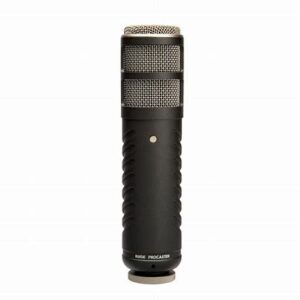
Pros:
- Exceptional sound quality
- Dynamic microphone with excellent off-axis rejection
- Solid build quality
- Internal shock mounting
- Included accessories
Cons :
- Limited versatility
- Requires gain
- Weight and size
- Price
The Rode Procaster is a dynamic microphone that is specifically designed for professional broadcast and voice-over applications. It is known for its exceptional sound quality, robust build, and reliable performance. Let’s take a closer look at the features and performance of the Rode Procaster.One of the standout features of the Procaster is its sound quality. It delivers a rich, warm, and detailed sound reproduction, making it well-suited for capturing vocals and spoken word. The microphone provides a smooth frequency response that enhances the clarity and intelligibility of the recorded audio. Whether used for radio broadcasts, podcasts, voice-overs, or interviews, the Procaster excels at capturing the nuances of the human voice with great accuracy.The Procaster’s dynamic design offers excellent off-axis rejection, meaning it effectively captures sound from the desired source while minimizing background noise and unwanted ambient sound. This is particularly important in broadcast and voice-over scenarios where a clean and focused sound is essential. The microphone’s ability to isolate the desired sound source results in professional-grade recordings with minimal interference.
Durability is another key aspect of the Procaster. It features a solid and rugged construction that can withstand the rigors of regular use. The all-metal body ensures longevity and reliability, making it suitable for both studio and field recording applications. The Procaster also includes an internal shock mounting system that helps minimize handling noise, ensuring clean and professional recordings.While the Procaster excels in its specialized applications, it may have some limitations for other recording purposes. Its tailored frequency response and directional characteristics make it less versatile for capturing musical instruments or live performances. Additionally, the Procaster requires sufficient gain to achieve optimal recording levels, so users may need a preamp or audio interface with ample gain capabilities.In terms of pricing, the Rode Procaster is positioned in the higher range compared to entry-level microphones. However, it offers professional-grade performance and durability, justifying the investment for those in need of a reliable and high-quality microphone for broadcasting and voice-over work.
6. Sennheiser MD 441-U
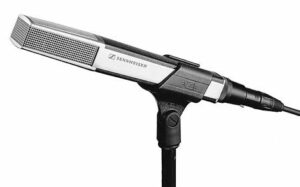
Pros:
- Outstanding sound quality
- Versatility
- Directionality options
- Robust build quality
- Integrated pop filter
Cons:
- Price
- Size and weight
- Phantom power requirement
The Sennheiser MD 441-U is a highly regarded dynamic microphone that has earned a reputation for its exceptional sound quality and versatility. It is a go-to choice for many professional recording engineers and musicians looking for a top-tier microphone. Let’s delve into a detailed review of the Sennheiser MD 441-U.First and foremost, the MD 441-U excels in delivering outstanding sound quality. It captures vocals and instruments with remarkable clarity and accuracy. The microphone has a natural and transparent sound reproduction, allowing the nuances of the sound source to come through with great detail. Whether used for vocals, drums, guitar amps, brass instruments, or any other application, the MD 441-U consistently delivers excellent audio fidelity.One of the notable features of the MD 441-U is its versatility. It is designed to handle a wide variety of sound sources with ease. The microphone’s wide frequency response and excellent transient response make it well-suited for capturing both subtle nuances and loud, dynamic sound sources. Its ability to handle high sound pressure levels makes it a popular choice for recording drums and guitar amplifiers, where it can capture the impact and punch of the instruments with precision.
The MD 441-U features a supercardioid polar pattern, which provides excellent off-axis rejection. This means it effectively captures sound from the front while minimizing unwanted noise and room ambience from the sides and rear. The microphone’s directionality ensures focused recordings and helps isolate the desired sound source, making it particularly useful in studio or live sound settings.Build quality is another area where the MD 441-U shines. It is built to withstand the demands of professional use, with a robust and durable construction. The microphone can handle rough handling and on-the-road applications without compromising its performance. Its solid build ensures longevity and reliability, giving users confidence in its ability to deliver consistent results.While the MD 441-U offers exceptional performance, there are a few considerations to keep in mind. Firstly, the microphone comes at a higher price point compared to many other microphones in its category. This may make it less accessible for those on a tighter budget. Additionally, the MD 441-U requires 48V phantom power to operate, so it is essential to have a compatible audio interface or mixer with phantom power capability to utilize the microphone effectively.
7. Aston Microphones Origin
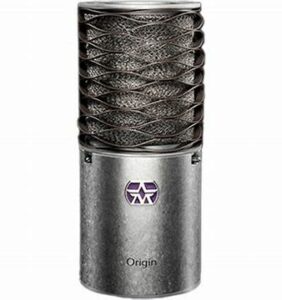
Pros :
- Exceptional sound quality
- Unique design and build quality
- Versatility
- Excellent off-axis rejection
- Included accessories
Cons :
- Price
- Limited directionality options
- Requires an external shock
The Aston Microphones Origin is a well-regarded microphone known for its exceptional sound quality, unique design, and versatility. It is a popular choice among recording engineers, musicians, and content creators looking for a reliable and visually striking microphone. Let’s dive into a detailed review of the Aston Microphones Origin.One of the standout features of the Origin is its exceptional sound quality. It captures vocals and instruments with remarkable clarity, detail, and accuracy. The microphone provides a balanced and natural sound reproduction that faithfully represents the original source. Whether used for vocals, acoustic instruments, or amplifiers, the Origin consistently delivers professional-grade audio performance.The Origin’s unique design is another aspect that sets it apart. With its distinctive wave-form mesh head, the microphone stands out visually and adds a touch of elegance to any recording setup. It is a well-built microphone with attention to detail, featuring high-quality materials that ensure durability and longevity.Versatility is another strong suit of the Origin. It is a versatile microphone that can handle a wide range of sound sources. Whether you’re recording vocals, acoustic guitars, drums, or podcasting, the Origin performs admirably in various scenarios. Its ability to capture a diverse range of instruments and voices with clarity and accuracy makes it a reliable choice for professionals and enthusiasts alike.
The Origin features a cardioid polar pattern, which provides excellent off-axis rejection. This means it effectively captures sound from the front while minimizing unwanted background noise and room reflections. The microphone’s directionality ensures focused recordings and helps isolate the desired sound source, resulting in clean and professional-sounding recordings.The Origin typically comes with a shock mount and a pop filter, which adds value and convenience for users. The shock mount helps reduce handling noise and vibrations, ensuring clean and clear recordings. The included pop filter helps minimize plosive sounds during vocal recordings, enhancing the overall audio quality.While the Aston Microphones Origin has many strengths, there are a few considerations to keep in mind. Firstly, the microphone is positioned at a higher price point compared to some other options in its category. This may make it less accessible for those on a tighter budget. Additionally, while the cardioid polar pattern is suitable for most recording situations, those requiring more directional options may need to explore alternative microphone choices.
In conclusion, selecting the right large diaphragm dynamic microphone under a budget of $300 is essential for achieving professional-quality audio recordings without breaking the bank. Throughout this article, we have explored the key points regarding the importance of choosing the right microphone and provided recommendations for the best options within this price range. When making the final decision, it is crucial for readers to consider their specific recording needs, preferred sound characteristics, and budget constraints. Factors such as the intended usage, desired tonal qualities, and the recording environment should be taken into account. It is recommended to audition and compare different microphones if possible, or thoroughly research user reviews and expert opinions to gain insights into their performance and suitability for specific applications. By investing time and effort into selecting the right large diaphragm dynamic microphone, readers can enhance their audio recordings and achieve professional-level results within their budget. Whether it’s capturing vocals, recording instruments, or creating podcast content, the recommended microphones offer a balance of performance and affordability. The journey to finding the perfect large diaphragm dynamic microphone under $300 requires careful consideration of individual recording needs, sound preferences, and budget limitations. The recommended microphones discussed in this article provide a solid starting point, each offering distinct qualities and advantages. By understanding one’s specific requirements and conducting thorough research, readers can confidently select the microphone that best suits their recording endeavors and unlock the full potential of their audio productions.

